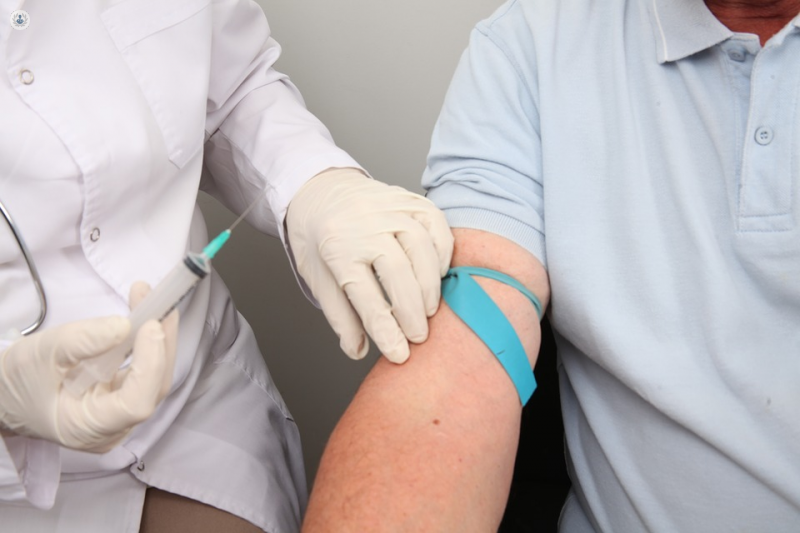Injections for osteoporosis
What are injections for osteoporosis?
There are a number of drug treatments for osteoporosis, some of which can be given in the form of an injection. The most common of these are zoledronic acid, which is given as a drip once a year for 3 years and denosumab which is given as an injection under the skin once every 6 months. The latter is a human antibody that deactivates the biological mechanism responsible for breaking down bone but does not prevent bone formation.

How do injection treatments work?
The body is constantly breaking down and rebuilding bone. Osteoporosis occurs when bone is broken down more rapidly than it is made, leading to hollow spaces appearing in the bone, like a honeycomb, weakening the structure.
Zoledronic acid is a bisphosphonate like alendronic acid. It slows down the cells which break down bone while having a lesser effect on the bone forming cells. Zoledronate prevents further loss of bone density as measured b DEXA
Denosumab is a human monoclonal antibody that can be produced in a laboratory to make osteoporosis injections. It targets the RANK ligand – a biological process in the body essential in breaking down bone. By targeting the RANK ligand, the injections slow the rate of bone breakdown while not having such a profound effect on bone formation. It improves osteoporosis as measured by DEXA and reduces the risk of a broken bone.
What are the side-effects of osteoporosis injections?
The common injectable therapies can both reduce the blood calcium level quite quickly, but this can be avoided by ensuring that patients have good levels of vitamin D before the injection as well as ensuring that kidney function is normal.
As both the common injections slow down the bone remodelling process, they could have other long term consequences for the bones, including atypical fractures in the major long bone in the leg (femur) and osteonecrosis of the jaw, although both are extremely uncommon in patients receiving these drugs for osteoporosis.
Zoledronic acid can give flu-like symptoms after the first injection, which can last 2-3 days and are partly reduced by taking paracetamol or ibuprofen. While osteonecrosis of the jaw does occur, it is extremely rare and the risk can be reduced by ensuring that patients have good dental health before treatment. Use of the drug is best avoided in those who may be planning invasive dental treatment such as dental implants.
Denosumab is a more recent development than zoledronic acid for osteoporosis treatment, and the long-term side-effects are slowly becoming known. Clinical trials and follow-up carried out over 8-10 years show that atypical femoral fractures and osteonecrosis of the jaw do occur, but may be even rarer than with other osteoporosis treatments. As bone breakdown recovers in part between injections, the drug is not retained in the bone for long periods. This means that, in principle, planned dental surgery could be undertaken in a short break between treatments. However, stopping treatment can lead to significant bone loss and increase in fractures in the year after stopping, so if a patient has to stop taking denosumab, it is important for them to get advice on how best to stop the treatment.
Other reported side effects of the drugs include:
- Back pain
- Musculoskeletal pain
- Pain in the extremities
- Bladder infections
What do osteoporosis injections involve?
Zoledronic acid injections are mixed with a solution and delivered by a drip over at least 15 minutes, usually by a nurse specially trained to give intravenous injections.
The denosumab injection is given in a pre-mixed solution that is injected under the skin, usually of the upper arm, thigh, or stomach area. It is injected once every six months by a doctor or nurse.
The patient may well be advised to take calcium and vitamin D supplements in addition to their injection treatment.
How do you prepare for osteoporosis injections?
Before the injections, your doctor should take a full medical history. You should inform them of any allergies or health conditions that you have, including if you have ever suffered from anaemia or low levels of blood calcium. You should tell them about your dental health. The doctor will also want to ensure that you have had a recent check of your kidney function and vitamin D level.
Are their other injectable treatments for osteoporosis?
For those with very severe osteoporosis or at imminent risk of fracture, injectable treatments can be used to build new bone more rapidly than by giving zoledronic acid or denosumab. These bone-forming drugs work by activating the cells which lay down new bone while having a delayed and lesser effect on the bone breakdown systems. Other drugs available to treat osteoporosis are teriparatide and romosozumab.







